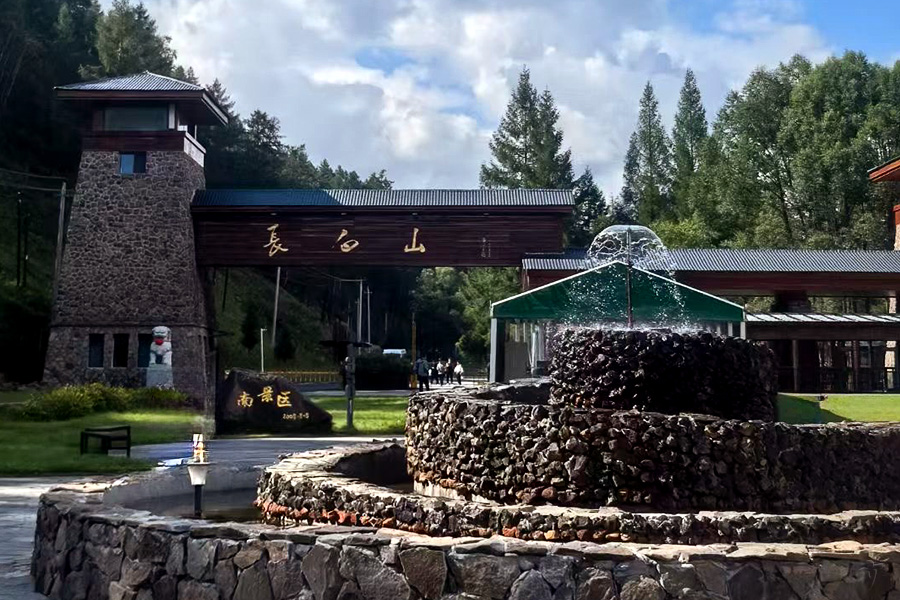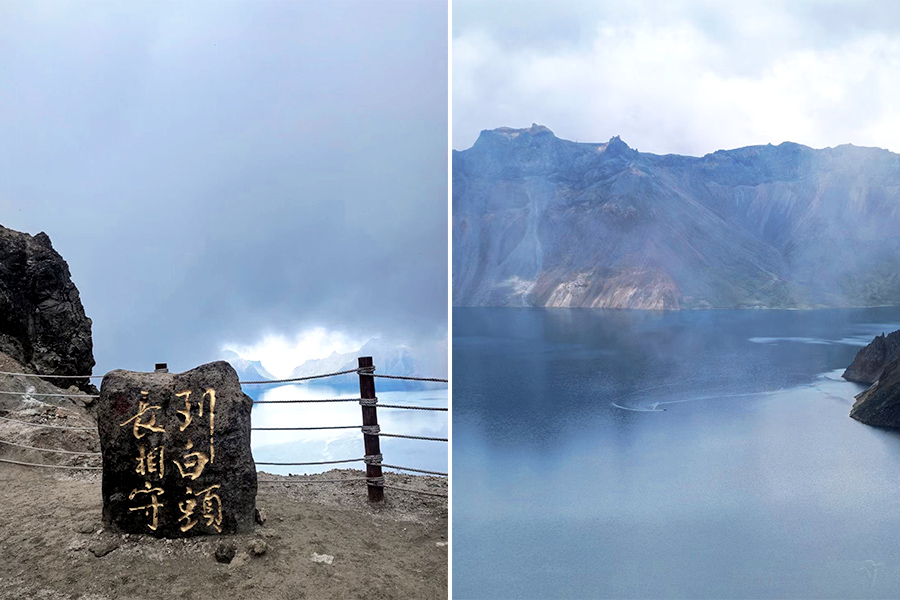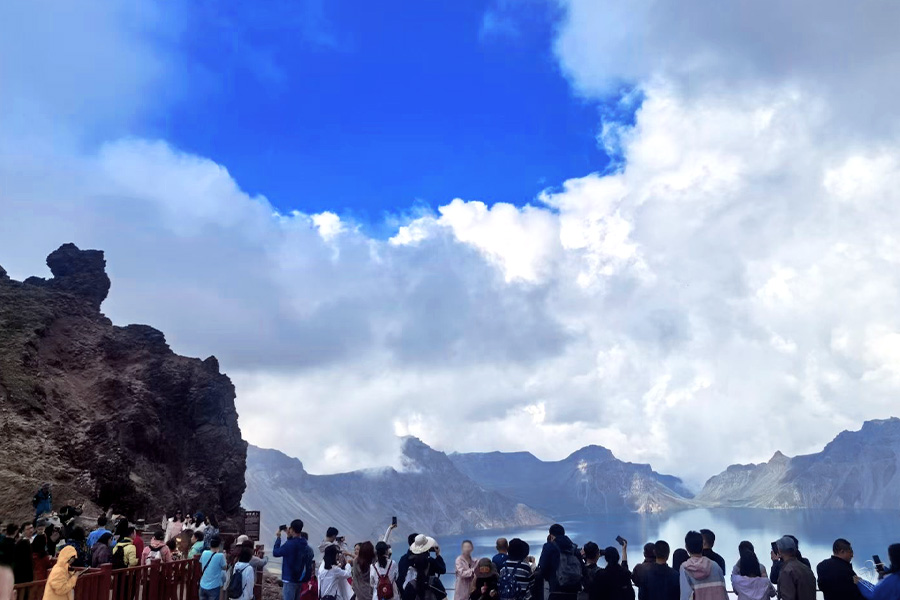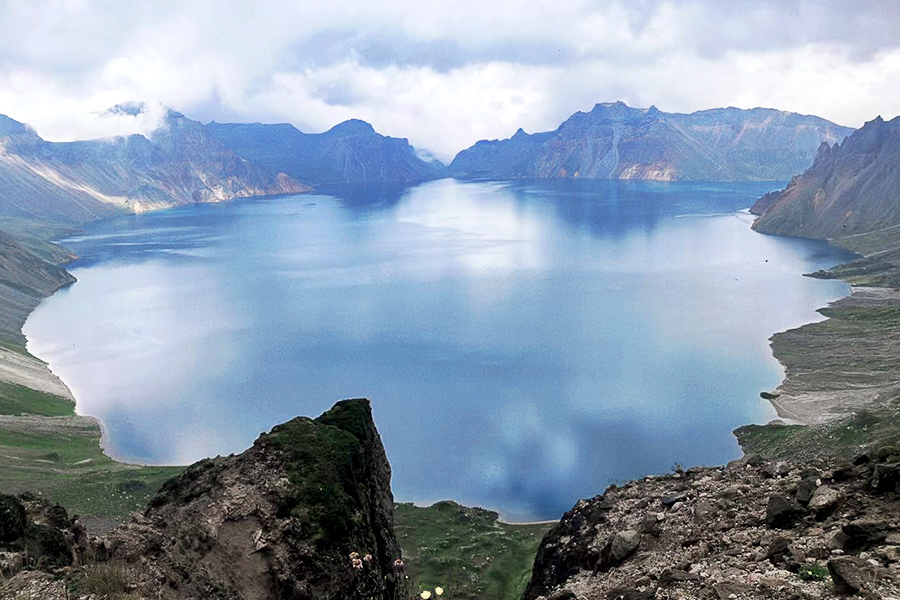Mt. Changbai

Chinese name: 长白山(Changbai Shan).
Location: situated in the Yanbian Korean Autonomous Prefecture, Jilin Province (bordering on North Korea).
Opening time: 08:00-16:00.
Ticket:
Ticket CNY125 + Green Bus CNY85 (bundling with tickets, for transfers inside the scenic area). Please note that outside vehicles can stop at the parking lot outside the entrance but are NOT allowed to enter the scenic area. After arriving at the entrance, tourists usually tour the mountain area by the Green Buses of the scenic area.
If tourists want to go to the Tianwen Peak (天文峰Tianwen Feng), the best place for watching the Lake Tianchi or officially Sky Pond (天池 Tian Chi, literally "Heavenly Lake" in English), they have to buy a ticket (CNY80) for a special transfer by 7-seat jeep or 10-seat van at the service station there. Due to the winding mountain road, the jeeps and vans are non-stop on the way to avoid rear-end collision. It is suggested that tourists who are carsick take anti-motion sickness drugs in advance.
How to get there:
- By air and bus: Changbai Mountain airport has flights to Beijing, Shanghai, Changchun, etc. The nearest airport away from Changbai Mountain is the Yanji Airport located at the western side of Yanji City, which has opened air routes to Beijing, Shanghai, Changchun and some other big cities. Arriving in Yanji City, tourist can take the non-stop buses at the South Bus Station of Yanji to the scenic area (about 4 hours' drive). Tourists can also get to Changchun by air first, and then go to the mountain by bus. And smaller cities around Changbai Mountain have airports that accommodate smaller airplanes, and with bus connections on to the mountain.
- By train: depart from Yanji to Erdao Baihe (name of the station: 白河Baihe ) first, and then take another train from Baihe to Changbaishan (长白山Changbai Mountain).

Best time for visiting Changbai Mountain & travel tips:
Mt. Changbai sits in the temperate zone with a continental mountain climate, featuring windy spring, short and cool and changeable summer, brumous autumn, long and cold winter, with an annual average temperature of -7℃ to 3℃. So visitors are strongly advised to check the weather forecast for the area before planning a trip to Changbai Mountain, unless you are particularly fond of foggy weather.
The best time to visit Chanbai Mountain is July, August and September, during which the mountain is covered with four landscape belts from Temperate Zone to Frigid Zone because of the vertical change of the mountain topography. While touring alone in the mountain, it is better to go along main roads or hire a local guide to guard against getting lost.
June 15 – July 15, during which snow cover on the mountain is not thawed completely and wild flowers are in full bloom, is commonly considered to be the best time to visit Mt. Changbai. And the most important thing is that more sunny days happen in this time and tourists probably have a change to see the Lake Tianchi, which is covered with mist and fog most of the time in a year.
July 15 – August 15 is peak season of visiting the mountain, it is cloudy or rainy and it is hardly possible to see the Lake Tianchi, though.
August 15 – September 15 is an invigorating time with many sunny days, and, the mountain is usually covered with colorful wild flowers and trees.
October – May of the next year is the best time for skiing and enjoying the hot spring on the mountain. But please note that the lowest temperature there may sink down to -40 ℃, so it is necessary to pay high attention to keeping warm (e.g. down jacket, hat, scarf, glove, snow shoes).
Hotels are offered both at the top and the foot of Mount Changbai. It is easy to check in and room prices vary of course with equivalent amenities at different seasons.
Brief Introduction to Mountain Changbai
Mountain Changbai, also well known as "Baekdu Mountain", "Baitou Mountain", "White-Headed Mountain", "Top 10 Mountains in China", is actually a dormant volcano and seen as a National Nature Reserve in China. That's why Mountain Changbai boasts rare animals, marvelous lakes, amazing hot springs, and forests that stretch to the horizon. There is splendid scenery during the clearly-defined four seasons, but it is especially beautiful in winter. The landscapes on Mount Changbai are of the picture-postcard variety, with over 30 scenic sites, 3 of which are profiled below, and which offer unique geographical characteristics of interest to nature lovers. The view from any of Mount Changbai's 16 tallest peaks is intoxicating, while the view from Tianbao Peak especially makes you feel that you are standing on the roof of the world.
Main Attractions in Changbai Mountain

- Lake Tianchi (Heavenly Lake, Sky Pond)
The most beautiful part of Changbai Mountain is undoubtedly the mysterious Lake Tianchi. The lake was formed in the crater of Changbai Mountain and is the source of the Songhua, Tumen and Yalu rivers. The altitude of the Heavenly Lake is 2189 meters (about 7,182 ft) and the average temperature is 7.3 C (45.14 F). Changbai Mountain is also the cradle of several Chinese ethnic groups especially the Manchu and the Korean nationalities.
At 2192 meters above sea level, Lake Tianchi represents an enormous natural reservoir, with a surface area of some 10 square kilometers. On a calm day in clear weather, the lake is just like a jade surrounded by 16 peaks, guarding it. Some say that the best season in which to watch the lake is during the cold months, while others claim that the cloudless sky in midsummer offers the clearest view of the lake and its surrounding peaks. There is a very interesting phenomenon while you walk along the lake. On many occasions it is common for sunshine and rain to occur at the same time. It may rain very hard at this minute, but soon you may find the sun shining warmly at the next minute. Sometimes, you can even watch it rain in the west and shine in the east. Besides the wonderful scenery and astonishing climate, many witnesses have claimed that there are monsters in the Lake Tianchi! It is said that some witnesses have took photos of the monsters as proof, but what species of creatures are is still a puzzle until now.
- Changbai Waterfall
On its northern rim, between Tianhuo Peak and Longmen Peak, Lake Tianchi spills over, forming the Chengcha River. 1250 meters farther below, the Chengcha River glides over a cliff, forming Changbai Waterfall. 68 meters below this, the river continues its journey down the mountain. By late fall, much of the force of the waterfall has dissipated, as has the Chengcha River itself, since this is a run-off river. In the dead of winter, the river and its waterfall, reduced to a trickle, eventually freeze solid. In the center of the lip where the Chengcha River spills over the cliff, forming Changbai Waterfall, is a large stone, dubbed "Niulangdu", that splits the waterfall into two halves. Behind the curtain of falling water is a cave-like depression in the mountain, which allows visitors a chance to go behind the waterfall and look out through it onto the slopes below. When the river is running at peak force, one cannot avoid being doused by the fine, vapor-like spray from the waterfall on making this behind-the-curtain journey. On this side of the mountain, the roar of the waterfall at peak force can be heard in the valley below, and because this is essentially run-off water from the melting winter ice pack on Mount Changbai, it is so cold that one can actually feel the chill in the air as one approaches the waterfall.
- Changbai Hot Springs
There are countless thermal springs on Mountain Changbai, some of which reach a temperature of 80 degrees Celsius (water at 100 degrees Celsius is boiling), hot enough to boil eggs, and since many of these hot springs contain minerals that have dyed the surrounding stones with bright colors such as blue, red, green and yellow, the local people - to the amusement of tourists, especially children - boil eggs in these springs, resulting in "Easter Eggs" in a variety of bright, natural colors. Many of these thermal springs have a perfect temperature for bathing, which many tourists indulge themselves in for the pure joy of it, while some of the thermal springs also possess a mineral content (not the discoloring kind!) that is said to be therapeutic. The most famous such hot spring spas are Changbai Hot Springs, Tiyun Hot Springs and Hubin Hot Springs. Lesser known spas include Reed Hot Springs, Celestial Bridge Hot Springs, Shibadaogou Hot Springs, Yujiang Hot Springs and Yaoshui Hot Spring. A steaming hot bath in one of these thermal springs on a winter day, surrounded by ice and snow, is said to be a tonic experience. There are also 13 thermal geysers here.
Besides these, Mountain Changbai has many a good scenery like the "Underground Forest" at the bottom of the valley, Black Wind Pass, Fairy Bathtub Pool, Cluster of Volcanoes, Grand Canyon, Chengcha River, Twin Lakes, Natural Museum, Great Valley, King's Lake as well as Tiger's Back, etc.. Mountain Changbai offers not noly the visiting tourist but also offers winter skiing, snowmobiling and ice skating, and if you are into alternative wines, the Mount Changbai area grows its own bilberries(bilberries are in the same family as blueberries, cranberries, deerberries, farkleberries, etc.) that are used to produce an organic bilberry wine. As an old saying goes in China, you can never get to know how interesting Mountain Changbai is if you don't have a chance to vitness and experience by yourselves.
Quick Questions
Our team is waiting for your questions. Please feel free to ask us any questions you might have about our China package tours, Chinese culture, or the sites available. We will gladly help you with any special needs you might have and all questions, like our trip designing is completely free of charge.





